GMC SIERRA 1994 Owners Manual
Manufacturer: GMC, Model Year: 1994, Model line: SIERRA, Model: GMC SIERRA 1994Pages: 404, PDF Size: 20.91 MB
Page 211 of 404
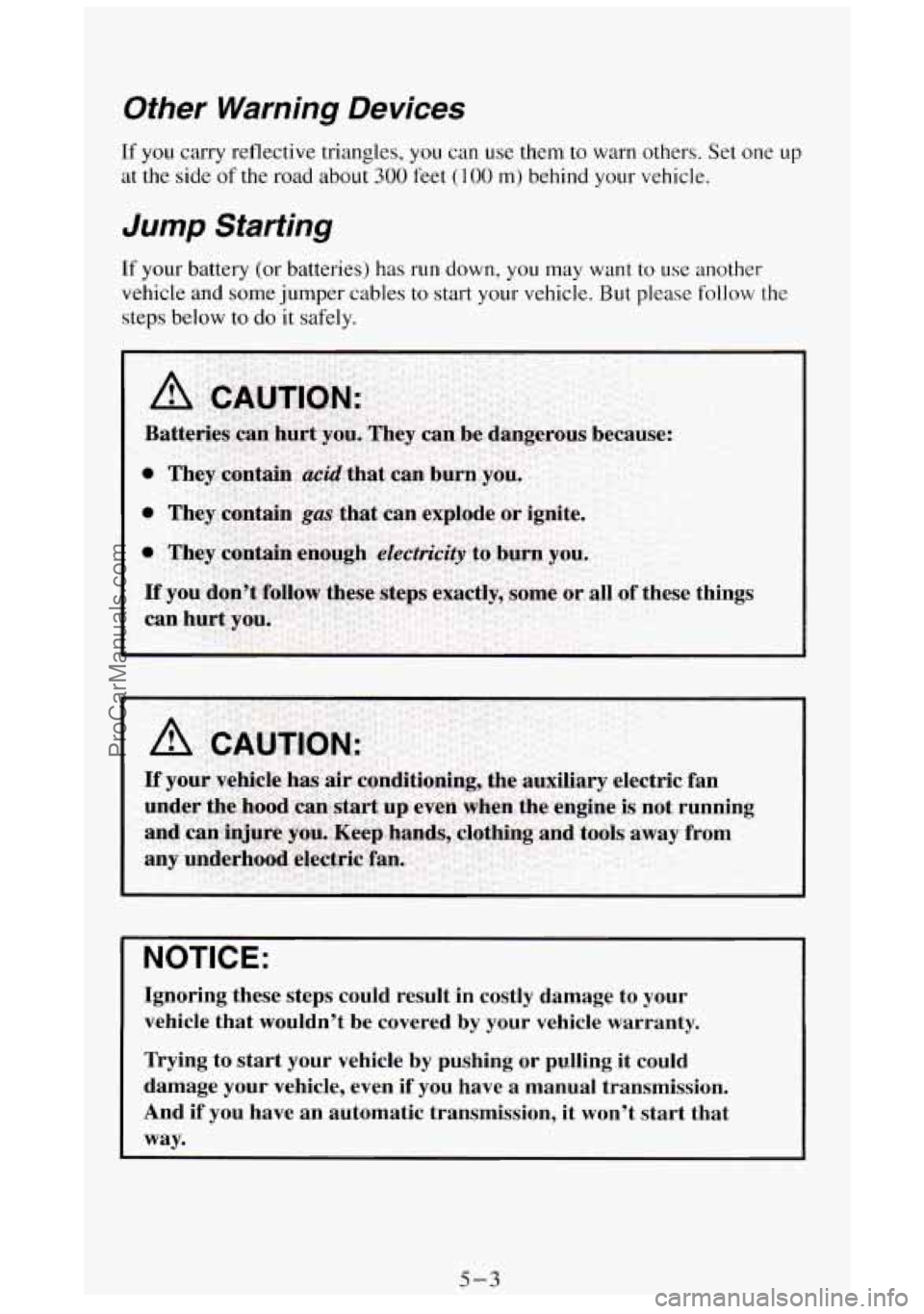
Other Warning Devices
If you carry reflective triangles, you can use them to warn others. Set one up
at the side of the road about 300 feet (1 00 m) behind your vehicle.
Jump Starting
If your battery (or batteries) has run down, you may want to use another-
vehicle
and some jumper cables to start your vehicle. But please follow the
steps below to do it safely.
things
NOTICE:
Ignoring these steps could result in costly damage to your
vehicle that wouldn’t be covered by your vehicle warranty.
Trying
to start your vehicle by pushing or pulling it could
damage your vehicle, even if you have a manual transmission.
And if you have an automatic transmission, it won’t start that
way.
5-3
ProCarManuals.com
Page 212 of 404
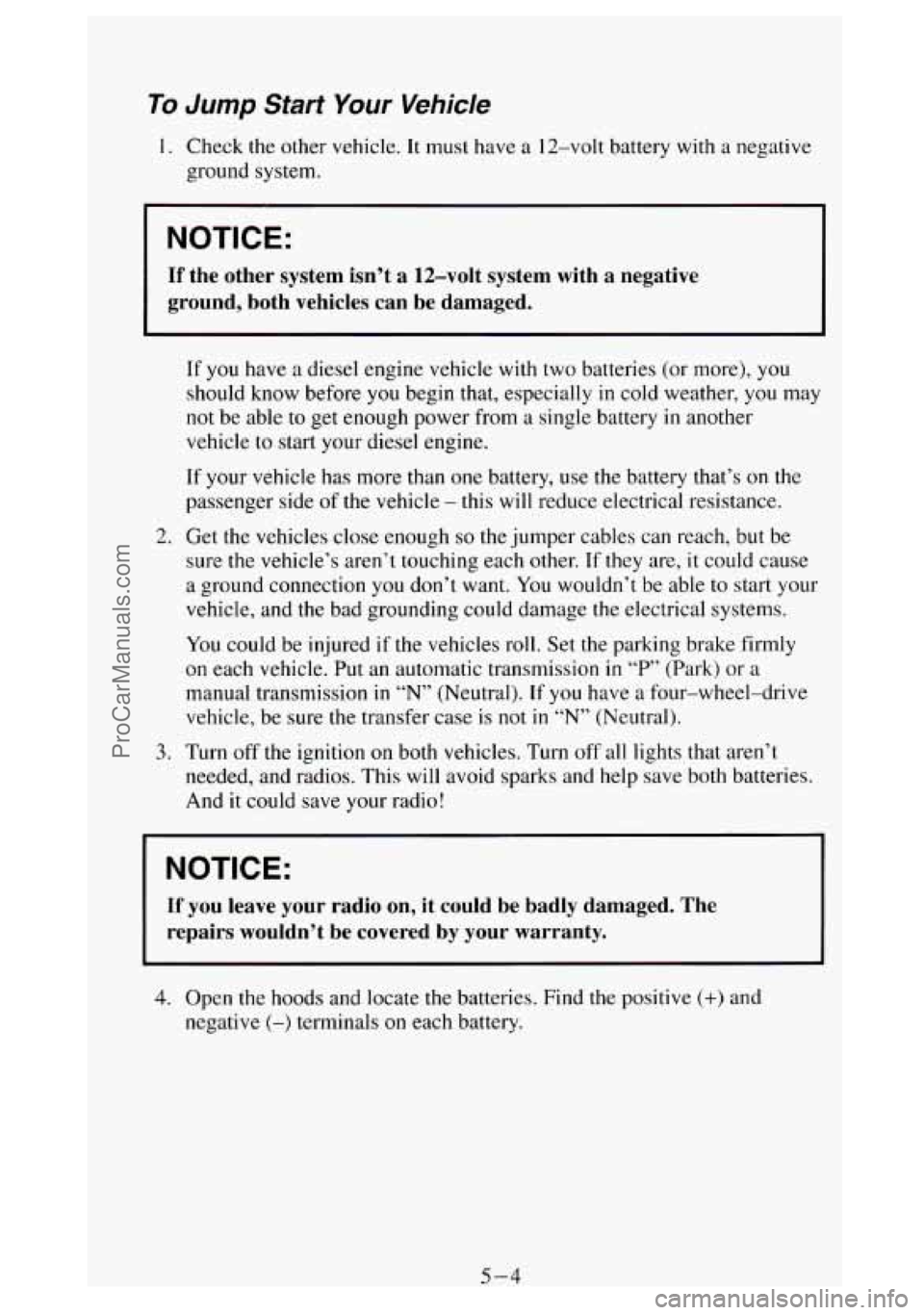
To Jump Start Your Vehicle
1. Check the other vehicle. It must have a 12-volt battery with a negative
ground system.
I NOTICE:
If the other system isn’t a 12-volt system with a negative
ground, both vehicles can be damaged.
If you have a diesel engine vehicle with two batteries (or more), you
should know before
you begin that, especially in cold weather, you may
not be able to get enough power from
a single battery in another
vehicle to start your diesel engine.
If your vehicle
has more than one battery, use the battery that’s on the
passenger side
of the vehicle - this will reduce electrical resistance.
sure the vehicle’s aren’t touching each other.
If they are, it could cause
a ground connection you don’t want. You wouldn’t be able to start your
vehicle, and the bad grounding could damage
the electrical systems.
You could be injured
if the vehicles roll. Set the parking brake firmly
on each vehicle. Put an automatic transmission
in “P” (Park) or a
manual transmission in “N” (Neutral). If you have a four-wheel-drive
vehicle, be sure
the transfer case is not in “N” (Neutral).
2. Get the vehicles
close enough
so the jumper cables can reach, but be
3. Turn off the ignition on both vehicles. Turn off all lights that aren’t
needed, and radios. This will avoid sparks and help save both batteries.
And it could save
your radio!
NOTICE:
If you leave your radio on, it could be badly damaged. The
repairs wouldn’t be covered by your warranty.
4. Open the hoods and locate the batteries. Find the positive (+) and
negative
(-) terminals on each battery.
5-4
ProCarManuals.com
Page 213 of 404
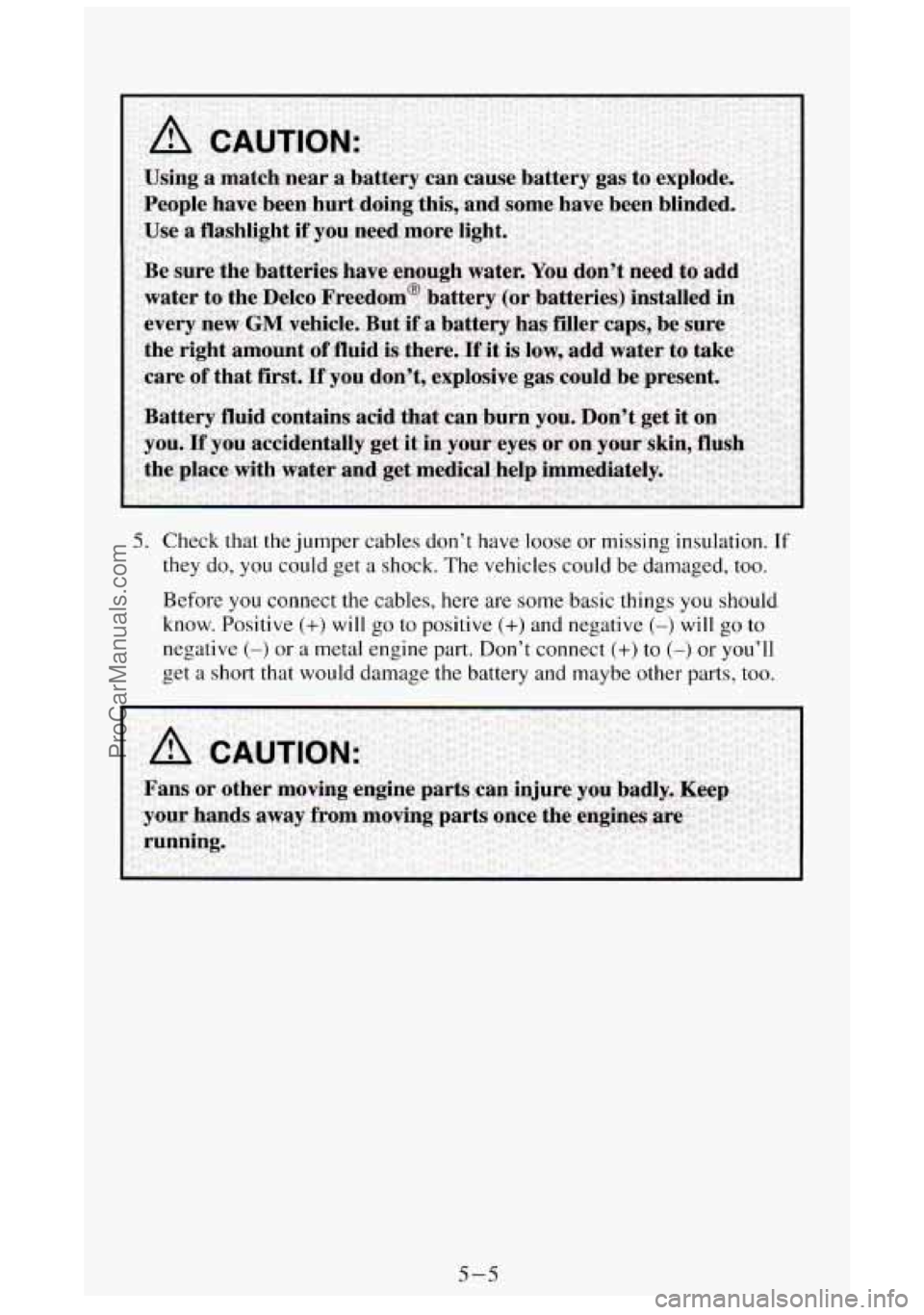
5. Check that the jumper cables don't have loose or missing insulation. 'Ir'
they do, you could get a shock. The vehicles could be damaged, too.
Before
you connect the cables, here are some basic things you should
know. Positive
(+) will go to positive (+) and negative (-) will go to
negative
(-) or a metal engine part. Don't connect (+) to (-) or you'll
get a short that would damage the battery and maybe other parts, too.
5-5
ProCarManuals.com
Page 214 of 404
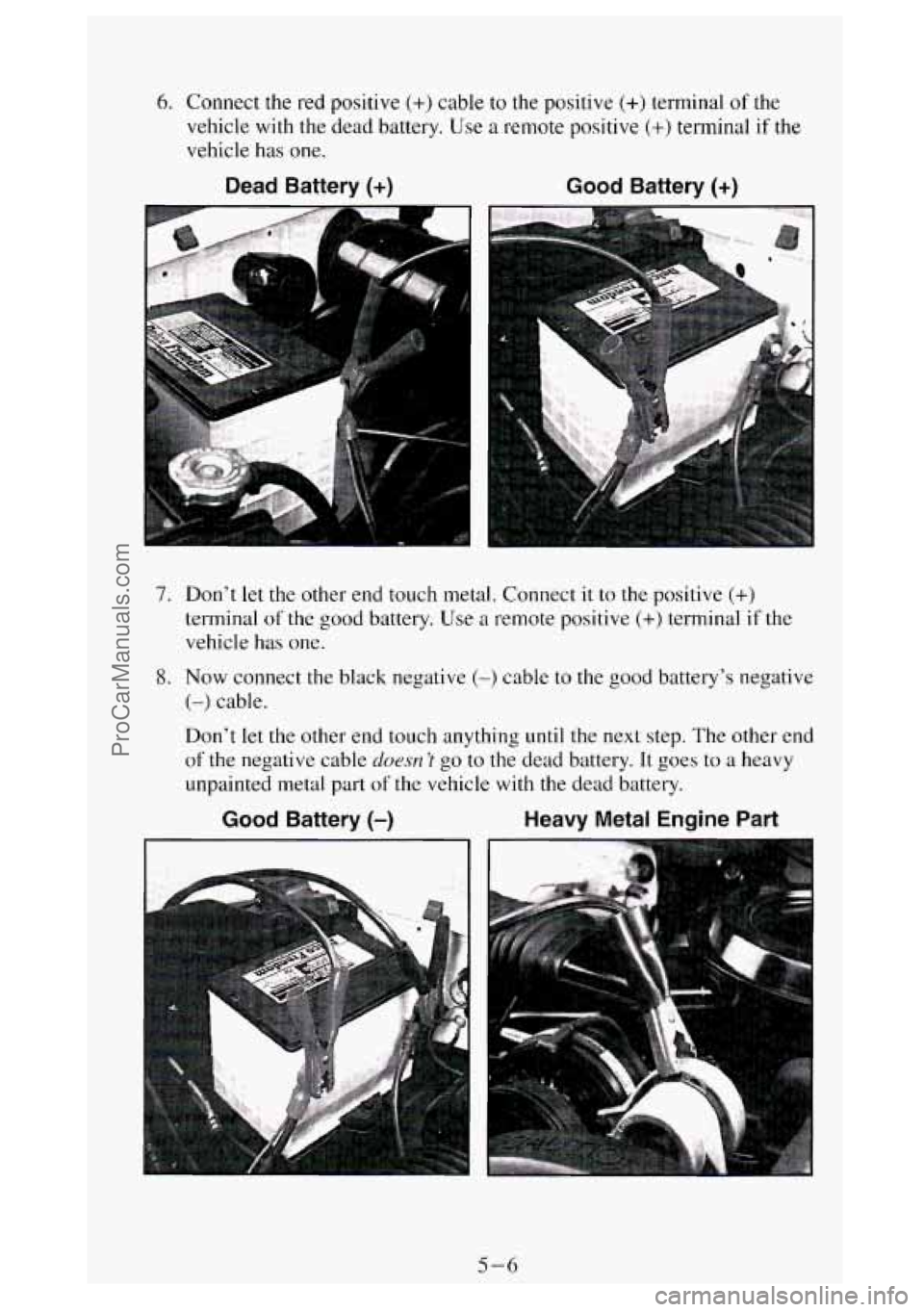
7. Don’t let the other end touch metal. Connect it to the positive (+)
terminal of the good battery. Use a remote positive (+) terminal if the
vehicle has one.
8. Now connect the black negative (-) cable to the good battery’s negative
(-) cable.
Don’t let the other end touch anything
until the next step. The other end
of the negative cable doesn’t go to the dead battery. It goes to a heavy
unpainted metal part
of the vehicle with the dead battery.
Good Battery (-) Heavy Metal Engine Part
5-6
ProCarManuals.com
Page 215 of 404
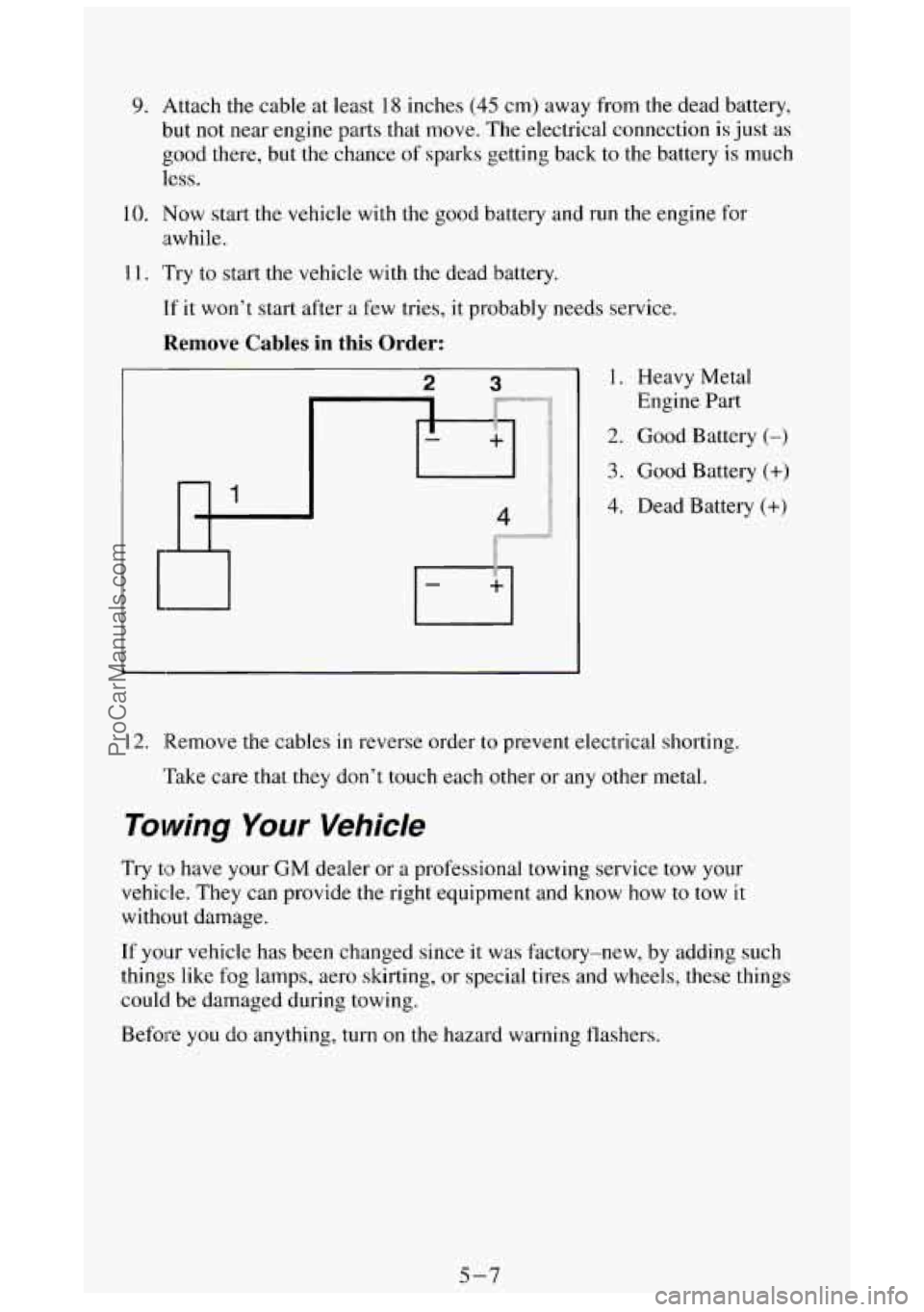
9. Attach the cable at least 18 inches (45 cm) away from the dead battery,
but not near engine parts that move. The electrical connection
is just as
good there, but the chance
of sparks getting back to the battery is much
less.
10. :Now start the vehicle with the good battery and run the engine for
awhile.
1 1. ‘Try to start the vehicle with the dead battery.
If it won’t start after a few tries, it probably needs service.
.Remove Cables in this Order:
2 3 1. Heavy Metal
Engine Part
2. Good Battery
(-)
3. Good Battery (+)
4. Dead Battery (+)
12. :Remove the cables in reverse order to prevent electrical shorting.
‘Take care that
they don’t touch each other or any other metal.
Towing Your Vehicle
Try to have your GM dealer or a professional towing service tow your
vehicle. They can provide the right equipment and know how to tow
it
without damage.
If your vehicle has been changed since
it was factory-new, by adding such
things like fog lamps, aero skirting, or special tires and wheels, these things
coulcl be damaged during towing.
Befolre you do anything,
turn on the hazard warning flashers.
5-7
ProCarManuals.com
Page 216 of 404
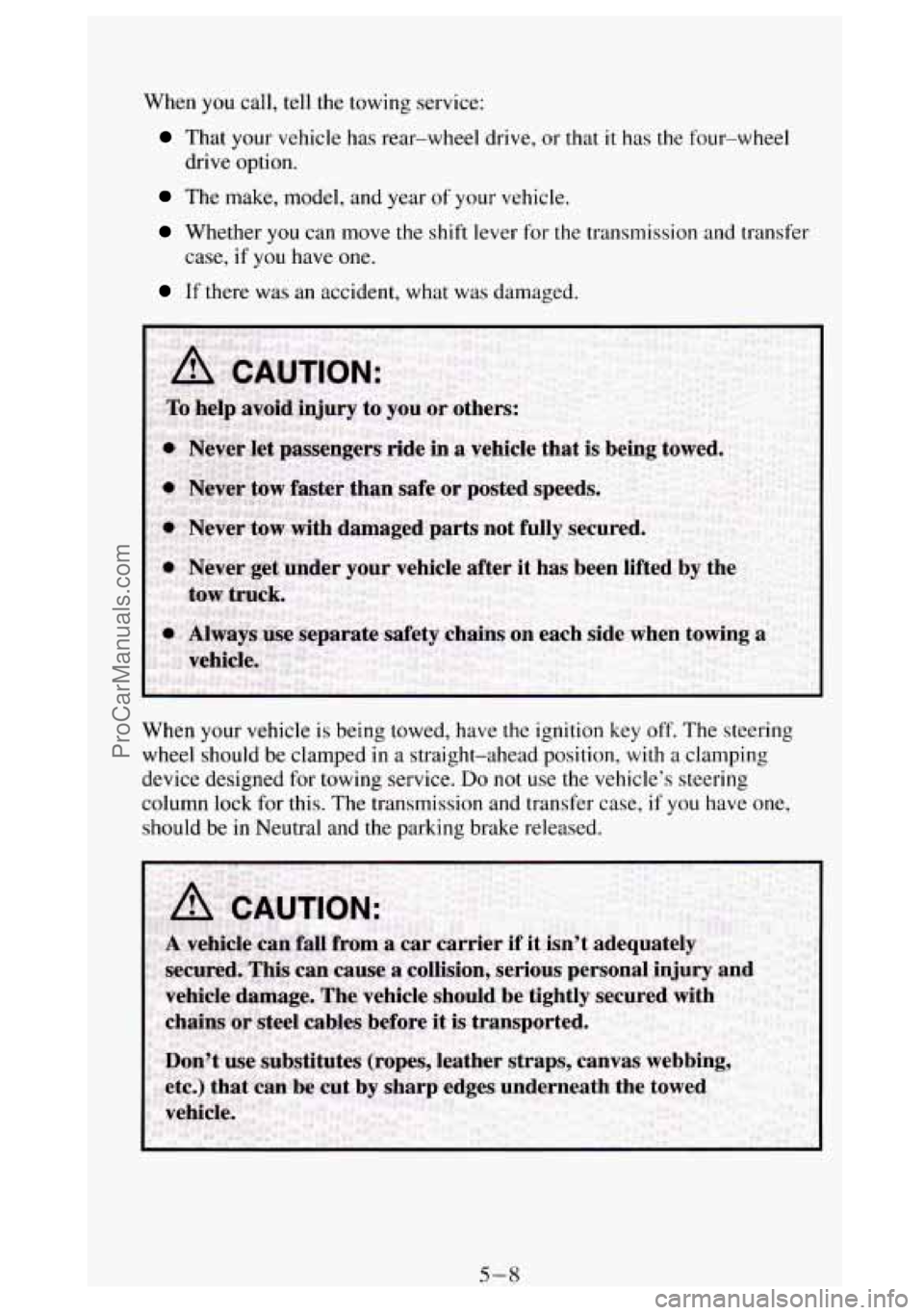
When you call, tell the towing service:
That your vehicle has rear-wheel drive, or that it has the four-wheel
drive option.
The make, model, and year of your vehicle.
Whether you can move the shift lever for the transmission and transfer
case,
if you have one.
If there was an accident, what was damaged.
1
When your vehicle is being towed, have the ignition key off. The steering
wheel should be clamped
in a straight-ahead position, with a clamping
device designed for towing service.
Do not use the vehicle’s steering
column lock for this. The transmission and transfer case,
if you have one,
should be in Neutral and
the parking brake released.
5-8
ProCarManuals.com
Page 217 of 404
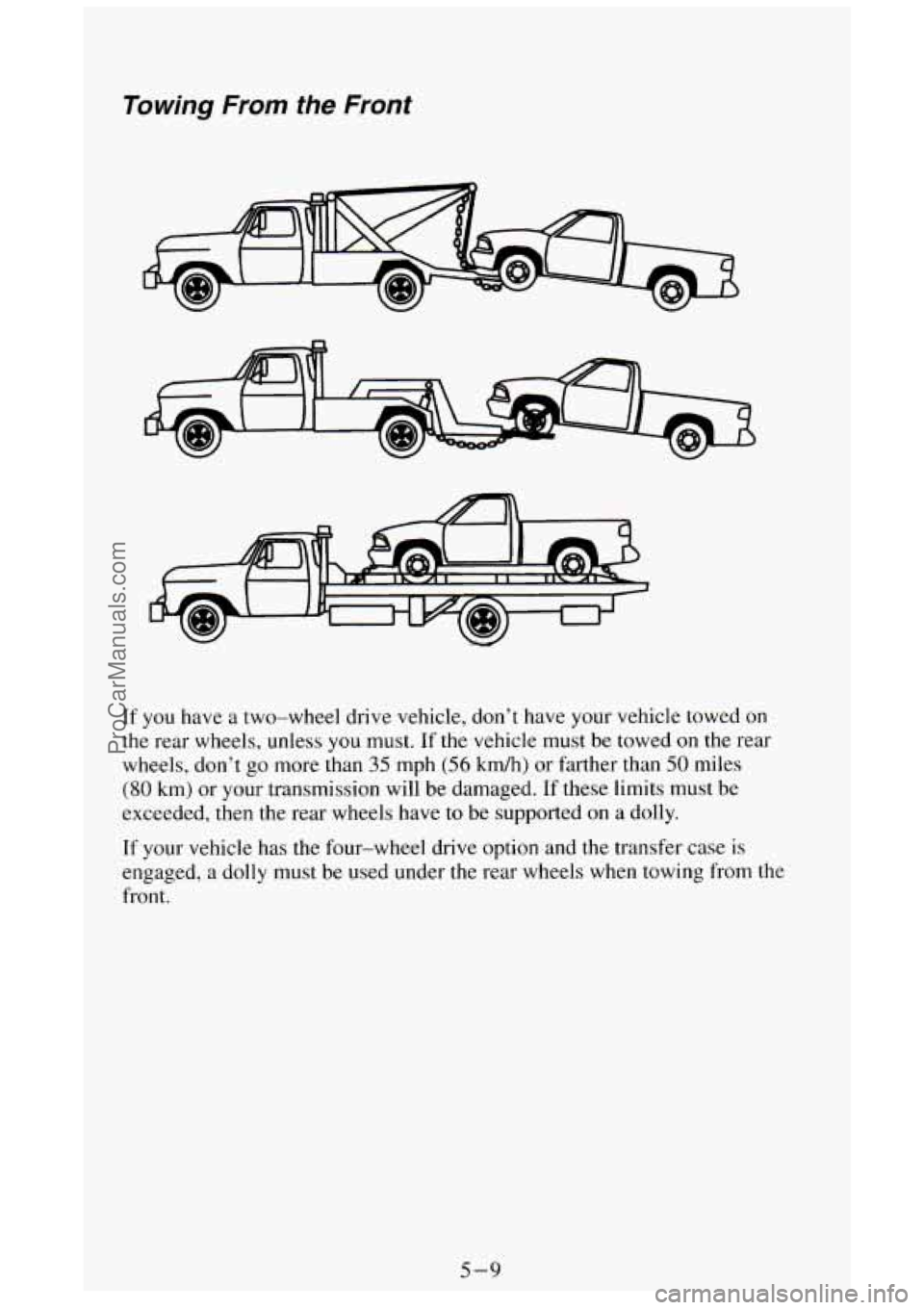
Towing From the Front
If you have a two-wheel drive vehicle, don’t have your vehicle towed on
the rear wheels, unless you must. If the vehicle must be towed on the rear
wheels, don’t go more than
35 mph (56 km/h) or farther than 50 miles
(80 km) or your transmission will be damaged. If these limits must be
exceeded, then the rear wheels have to be supported
on a dolly.
If your vehicle has the four-wheel drive option and
the transfer case is
engaged, a dolly must be used under the rear wheels when towing from the
front
.
5-9
ProCarManuals.com
Page 218 of 404
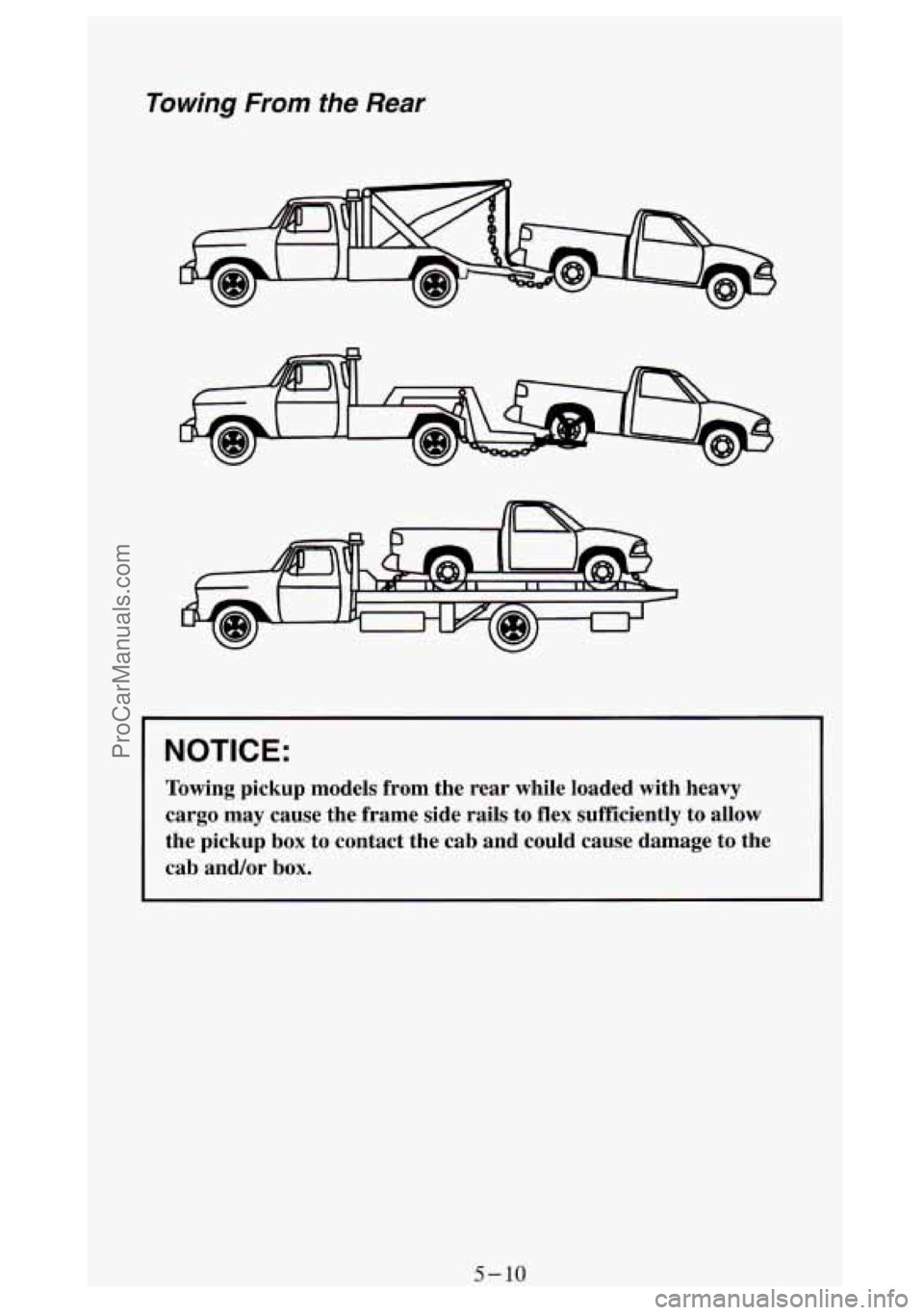
Towing From the Rear
r
NOTICE:
Towing pickup models from the rear while loaded with heavy
cargo may cause the frame side rails to flex sufficiently to allow
the pickup box to contact the cab and could cause damage to the
cab and/or box.
5-10
ProCarManuals.com
Page 219 of 404

,ngine Overheating
You will find a coolant temperature gage on your vehicle instrument panel.
If you have a diesel engine, you will also find a low coolant light on your
instrument panel.
If Steam 1s Coming From Your Engine
NOTICE:
If your engine catches fire because you keep driving with no
coolant, your vehicle can be badly damaged. The costly repairs
would not be covered by your warranty.
5-11
ProCarManuals.com
Page 220 of 404
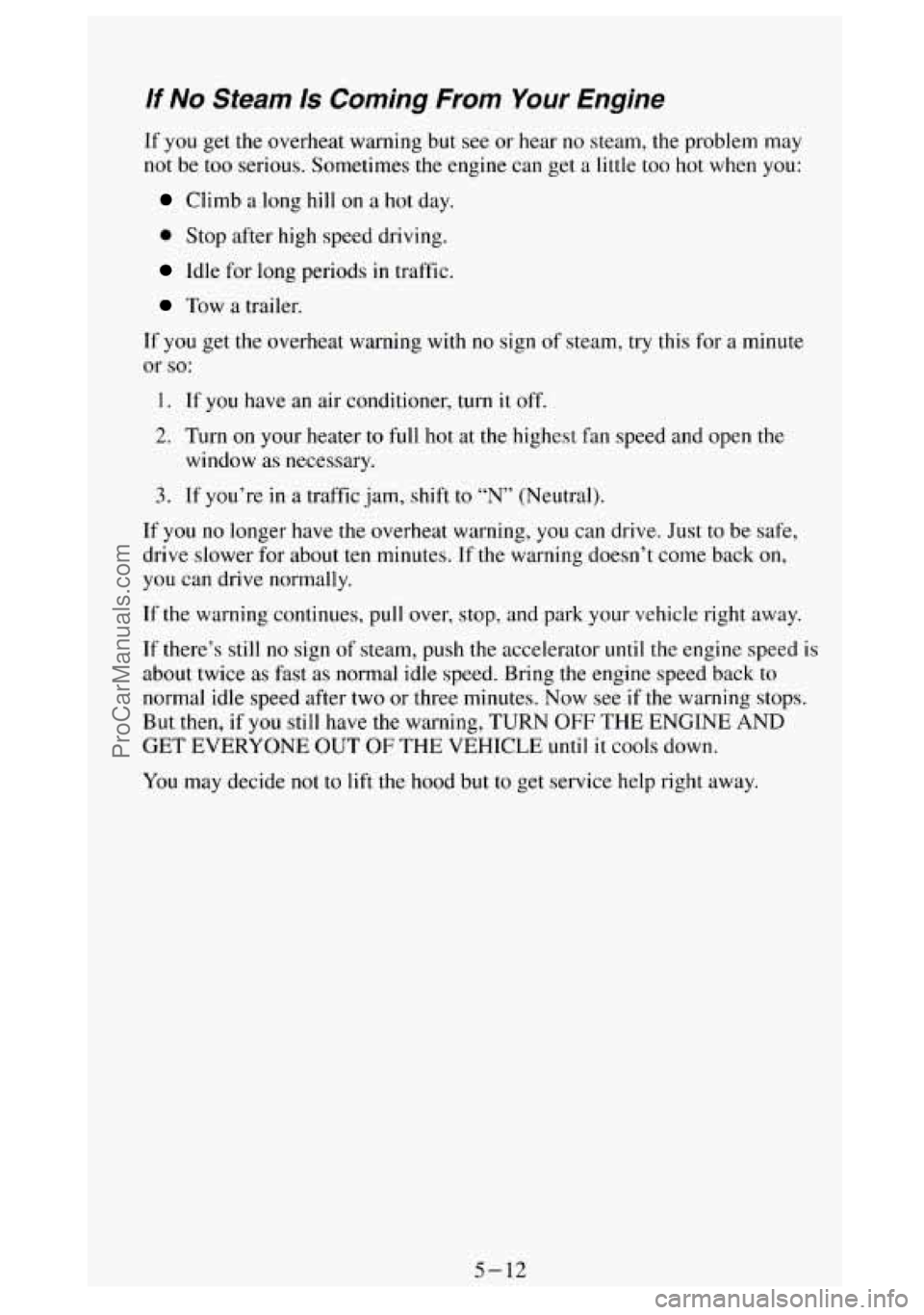
If No Steam Is Coming From Your Engine
If you get the overheat warning but see or hear no steam, the problem may
not be too serious. Sometimes the engine can get a little too hot when you:
Climb a long hill on a hot day.
0 Stop after high speed driving.
Idle for long periods in traffic.
Tow a trailer.
If you get the overheat warning with no sign of steam, try this for
a minute
or
so:
1. If you have an air conditioner, turn it off.
2. Turn on your heater to full hot at the highest fan speed and open the
window as necessary.
3. If you’re in a traffic jam, shift to “N” (Neutral).
If
you no longer have the overheat warning, you can drive. Just to be safe,
drive slower for about ten minutes. If the warning doesn’t come back
on,
you can drive normally.
If the warning continues, pull over, stop, and park your vehicle right away.
If there’s still no sign of steam, push the accelerator
until the engine speed is
about twice
as fast as normal idle speed. Bring the engine speed back to
normal idle speed after two or three minutes.
Now see if the warning stops.
But then,
if you still have the warning, TURN OFF THE ENGINE AND
GET EVERYONE OUT OF THE VEHICLE until it cools down.
You
may decide not to lift the hood but to get service help right away.
5-12
ProCarManuals.com